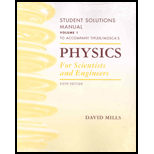
Concept explainers
(a)
The magnitude and the direction of the force exerted.
(a)
Explanation of Solution
Given:
Four point charges placed at corners of a square whose edge length is L.
Formula used:
Write the expression for the net force acting on
Here,
Write the expression for the
Here,
Write the expression for the
Here,
The magnitude of charge
Here,
Substitute
Substitute
Substitute
Calculation:
Substitute
Conclusion:
Thus, the magnitude and the direction of the force is
(b)
The magnitude of the electric field.
(b)
Explanation of Solution
Formula used:
Write the expression for the electric field at
Here,
Write the expression for the electric field due to charge
Here,
Write the expression for the electric field due to charge
Here,
Write the expression for the electric field due to charge
Here,
Write the expression for the electric field due to charge
Here,
Substitute
Substitute
Substitute
Substitute
Calculation:
Substitute
Conclusion:
Thus, the magnitude and the direction of the electric field is
Want to see more full solutions like this?
Chapter 21 Solutions
Physics For Scientists And Engineers Student Solutions Manual, Vol. 1
- A −5nC point charge is on the x-axis at x = 1.2m A second point charge Q is onthe x-axis at -0.600m. What must be the sign and magnitude of Q for the resultantelectric field at the origin to be (a) 45.0N/C in the +x-direction, (b) 45.0N/C in the -x-direction?arrow_forwardPoint charges q1=-4.5 nC and q2=+4.5 nC are sepa-rated by 3.1 mm, forming an electric dipole. (a) Find the electric dipole moment (magnitude and direction). (b) The charges are in a uniform electric field whose direction makes an angle of 36.9° with the line con-necting the charges. What is the magnitude of this field if the torque exerted on the dipole has magnitude 7.2*10-9 N#m?arrow_forwardTwo metal spheres, one carrying a 8.0-μC charge and the other carrying a -21-μC charge, are initially 100 mm apart. They are brought in contact with each other and then moved back to their original positions. What is the numerical value of the ratio FEi /FEfFiE/ FfE, where FEiFiE is the magnitude of the electric force between the spheres before they are brought in contact and FEfFfE is the magnitude of that force after they are brought together and then moved back to their initial positions?arrow_forward
- Can you arrange the two point charges q1=2.0106C and q2=4.0106C along the x-axis so that E=0 at the origin?arrow_forwardA long copper cylindrical shell of inner radius 2 cm and outer radius 3 cm surrounds concentrically a charged long aluminum rod of radius 1 cm with a charge density of 4 pC/m. All charges on the aluminum rod reside at its surface. The inner surface of the copper shell has exactly charge to that of the aluminum rod while the outer surface of the copper shell has the same charge as the aluminum rod. Find the magnitude and direction of the electric field at points that are at the following distances from the center of the aluminum rod: (a) 0.5 cm, (b) 1.5 cm, (c) 2.5 cm, (d) 3.5 cm, and (e) 7 cm.arrow_forwardCalculate the angular velocity of an electron orbiting a proton in the hydrogen atom, given the radius of the orbit is 0.5301010 m. You may assume that the proton is stationary and the centripetal force is supplied by Coulomb attraction.arrow_forward
- A rod 14.0 cm long is uniformly charged and has a total charge of 22.0 C. Determine (a) the magnitude and (b) the direction of the electric field along the axis of the rod at a point 36.0 cm from its center.arrow_forwardTwo uncharged, conducting spheres are separated by a distance d. When charge -Q is moved from sphere A to sphere B, the Coulomb force between them has magnitude F0. (a) Is the Coulomb force attractive or repulsive? (b) If an additional charge -Q is moved from A to B, what is the ratio of the new Coulomb force to the original Coulomb force, Fnew /F0? (c) If sphere B is neutralized so it has no net charge, what is the ratio of the new to the original Coulomb force, Fnew /F0?arrow_forward
 College PhysicsPhysicsISBN:9781285737027Author:Raymond A. Serway, Chris VuillePublisher:Cengage Learning
College PhysicsPhysicsISBN:9781285737027Author:Raymond A. Serway, Chris VuillePublisher:Cengage Learning College PhysicsPhysicsISBN:9781938168000Author:Paul Peter Urone, Roger HinrichsPublisher:OpenStax College
College PhysicsPhysicsISBN:9781938168000Author:Paul Peter Urone, Roger HinrichsPublisher:OpenStax College
 Principles of Physics: A Calculus-Based TextPhysicsISBN:9781133104261Author:Raymond A. Serway, John W. JewettPublisher:Cengage Learning
Principles of Physics: A Calculus-Based TextPhysicsISBN:9781133104261Author:Raymond A. Serway, John W. JewettPublisher:Cengage Learning



